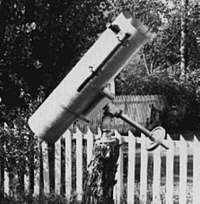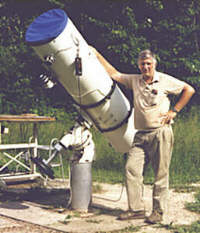
| EQUATORIAL MOUNT | MIRROR CELL | DIAGONAL HOLDER | 4 X 5 ASTROCAMERA | 90 mm Astrograph | JSP Homepage |
Believe it or not, I have been taking astrophotos off and on for most of those years. My very first successful astrophoto was taken of the Big Dipper with a box camera on a tripod. What's even more amazing is that I still have this negative. I was about 10 years old at the time.
My first astrophoto through a telescope was of Vega, made by holding the camera to the eyepiece of a 3" reflector made from a kit purchased from Edmound. The kit consisted of a 3" mirror, diagonal, paper tube and instructions. I still have that negative also, which shows just one star and lots of fingerprints from fondling this trophy for hours on end. I was about 11 at that time.
The next step up was to actually build my own 4 1/4" reflector, including grinding and figuring the mirror. I was 13 at this time and managed to take a picture of the Moon that is not too bad, all things considered. This photo is hanging in my gallery.
My next project was to build an 8" telescope which I still have and have taken many nice pictures with it, that can be seen in my web pages. There was a long gap between making this scope and actually being able to take photos with it and most of that time it spent in the closet. It is a quantum leap from star trails and hand held cameras to guided, deep sky photos and the leap requires (among other things) being in a location where the skies are dark enough to take long exposures. Not the least of those "other things" is a good mount and this was finally procured after moving out to the country.

![[picture of 8 inch]](8inch.jpg)
T
he 8 Inch Newtonian, Circa 1996
The mirror for this scope was completed by the author in 1963 and the rest has evolved over the years. The AstroPhysics 1200 mount was added in 1995 and marks the beginning of its use in astrophotography.
The 4" F12 guide scope was the first mirror made by the author and has been refigured to F7 as the longer scope was not stable enough for guiding.
The 4 X 5 camera has also been extensively redesigned since the photo was taken. This was essentially a fixed box attached directly to the tube. Focusing was done by sliding the diagonal back and forth. The camera had to be removed and a focuser remounted to use normal eyepieces. The current design slides directly into a two inch focuser and is much more compact. It however, is limited to a 2" circular field but that is about all the scope is capable of anyway.
It was decided that a longer focal length was needed to provide a larger image scale for small, deep sky objects and the development of a 10" F 6 was undertaken as a good option and well suited to the mount.
![[picture of 10 inch]](teninch.jpg)
T
he 10 Inch Newtonian
The mirror for this scope was completed in 1996 and saw first light on May 7. It represents a significant improvement over the 8" and there are a number of photos on these pages where direct comparisons can be made.
One of the first objects I looked at with it was M57, the Ring and the difference is really dramatic. It is much brighter in spite of being larger as a result of the longer focal length.
I also note that the focussing is much more forgiving at F6 than at F5. This is particularly
important in photography.
The mount handles the extra weight and length quite will but I would be reluctant to
go much larger.

The 16" OTA was a commercial Dobsonian "light bucket" that was received with
a grossly astigmatic and undercorrected primary. After months of waiting,
a new mirror was received that was even worse than the original.
After spending about 3 months refiguring the mirror myself, it is now my pride
and joy and deserving of something better that the kicking and shoving on a
Dob mount. On good nights, the view of Mars was like nothing I had ever
seen before. However, keeping it centered in a fast scope is so frustrating
that I would frequently go back to the 10" just to enjoy the view even though it
was much inferior.
I looked into Dob drivers but every time I looked at the mount I already owned,
I just could not get into the idea of trying to turn a sow's ear into a silk purse.
Against the advice of many, including the folks who made the mount, I decided
to tempt fate. I would have been more than satisified if it would not bend too
much and more or less keep things centered. I assumed I had taken my
last astrophoto.
Well, much to my delight, not only did it not "bend" or show any other signs
of overload, but any problems with photography will be with the scope and
not the mount. If there is a better mount on the market for the price, I
do not know what it is.
This camera was made from a surplus lens bought from
a posting on the intenet.
It is described in detail on its own page Astrograph
This telescope was designed to evaluate seeing
conditions. It has the same general dimensions as the one used by Pickering when he
established his 10 level seeing valuation.
It is a 5" Newtonian of 50" focal length. For details of the mount, cell and diagonal
holder, see the links at the top of this page.
For a discussion on seeing and how and why it is evaluated,
Seeing
This camera has been under development for about a year and will be offered to the public when the author is satisfied with the design.
This discussion has been moved to the JSP 4x5 Astrocamera. [Camera] page.
.
js
![[astrograph]](astrog.jpg)
T
he 90 MM Astrograph
![[astrograph]](pick.jpg)
T
he "Pickering 5"
Seeing Evaluation Telescope
![[picture of camera]](camera.jpg)
T
he 4 X 5 Camera